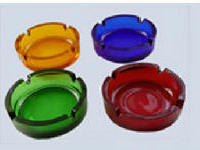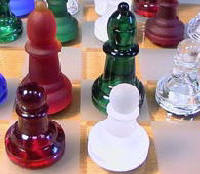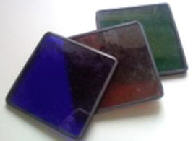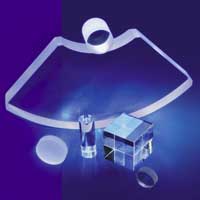Glass s an amorphous (non-crystalline) very viscous mass. It is produced by sintering of various metal salts. Main composition of glass are salts of alkaline and alkaline-earth metals (Na, K) and their oxides. ОTypical river sand consists of the same metal oxides and some non-metals, for example, silicon oxide SiO2 included in compositione of quartz glass. Typical window glass is a silicate of Na2O•CaO•6SiO2.



Sometimes in the glass arise zones of crystallization, what causes loss of strength of glass. Get a glass fused silica sand SiO2, limestone СаСО3 и soda Na2CO3:
The process is carried out in furnaces at the temperature of 1100-1600 °, then the formed glass melt gradually cooled.
Typical glass is softened at 500-600 °С. There are also natural glass, which is called "obsidian". This substance is widely used in jewelry.
In technology and medicine are widely used quartz glass. Unlike Typicaly window glass the quartz glass skips the ultraviolet rays
Quartz glass
Quartz glass оis formed with the rapid cooling of fused quartz (crystalline silicon dioxide SiO2). Quartz glass has chemical resistance and due to this property it is used for production laboratory ware. Quartz almost does not expand when it heated, so, if silica glass heated red-hot and repid to cool in water, it will not have crack.

Melting temperature, which characterizes the body of crystal structure, the glass does not have: softening as temperature increase occurs gradually. Substances with such properties are called - glassy or glass. Confirmation, that the glass is very viscous amorphous body, You can check the thickness of Your window, at home. Try to measure its thickness from above and from below - if it is sufficiently old, it will not be the same (the glass is coming down).
The viscosity of the glass. The concept of viscosity the property of a liquid (or gas) to resist the movement of individual layers relative to each other, as well as the movement of solid body in liquid.
In the International system of units (SI) viscosity has the dimension PA•s, but in common practice the unit of viscosity: 1 Pois (or P) = 0.1 PA•S. It is named after the French physicist Jean Louis Poiseuille (1799-1869).
Estimates, that based on the definition of viscosity heated above 500 ° C glasses, give to 20 °C is 1021 P.
For comparison: the viscosity of water at 20 C is 0.01 P, glycerin - 15 P, resin - about 108 P.
Viscosity of the glass in comparison, for example, in 10 trillion times more viscous than resin.
Glass, is difficult to define: is it solid or liquid. It has properties of solids, but at the same time has the structure of liquids
Why it is not crystallized after the melting and subsequent cooling? The thing is that, when it cools, the viscosity increases very quickly, and ions do not have time to adjust and to form a regular crystal lattice. Similarly behaves, for example, glycerin, which is difficult crystallizes (Tmelt=20 C).In glassy state, you can get even metal, if it melted, and then cool down with great speed - the millions of degrees per second.
However, in special conditions, the glass can be obtained in the crystalline state. Such materials are called to Sitaram
They have valuable mechanical, optical (including the color of the glass) and electrical properties that can purposefully change, changing their chemical structure
Introduction to melt certain elements allows to receive various color and change its properties. For example, to color glass changed to green or yellow, chromium ions or it oxides entered in the melt. Color of glass - orange - get by adding silver; light blue color gives cobalt Co. Bottled color or emerald green gives iron, copper – light blue or blue. When making in the melt gold ion it gets blood red color. When added to liquid glass boron get high-strength glassthat is used in chemical laboratories. Special mechanical properties has crystal glass, which differs from the ordinary presence of ions of lead and barium.
Crystal glass
Crystal glass — is a variety of glass containing significant amounts of oxide of lead (PbO) and, possibly, barium oxide BaO. The addition of lead oxide increases the refractive index and dispersion of light in him (with jewelry points - "play of color", "fire"). Additive barium oxide mainly increases the refractive index. The addition of lead oxide increases plastic properties and, accordingly, opportunities for mechanical processing - cutting, carving, etc.

Faceted crystal, like the faceted of precious stones, enables crystal to fully display properties, due to a higher refractive index and dispersion.
The name was given by analogy with rock crystal. Made by fusing lead oxide PbO with silica compound of sodium or of potassium (soda or potash) and small additives of other oxides.
Lead-potassium silicate glass is more expensive lime, but they are easier to melt and easier to manufacture. This allows the use of high concentrations of Lead and low - alkaline metal. The high contents of PbO gives high values of the refractive index and dispersion - the two parameters are very important in some optical applications. The same characteristics give lead glasses the glitter and Shine that decorate the most refined products tableware and art.
Crystal glass is a lead-silicate glass containing 13-30 % or more of oxides of lead and up to 17 % of potassium oxides. Crystal glass is used in production high-quality ware and decorative products. He has a high mass, transparency, refraction and brilliance, but less resistance for temperature, if compare it with other types of glass. Due to the content of lead and specific selection of the angles formed by the faces of the crystal glass, wares that made from it unusually bright and have many color of light on surfaces. Crystal glass has a beautiful bells. Crystal glass is also known as high quality Venetian and Czech glass.
Methods of processing products from crystal glass are engraving, polishing, carving.